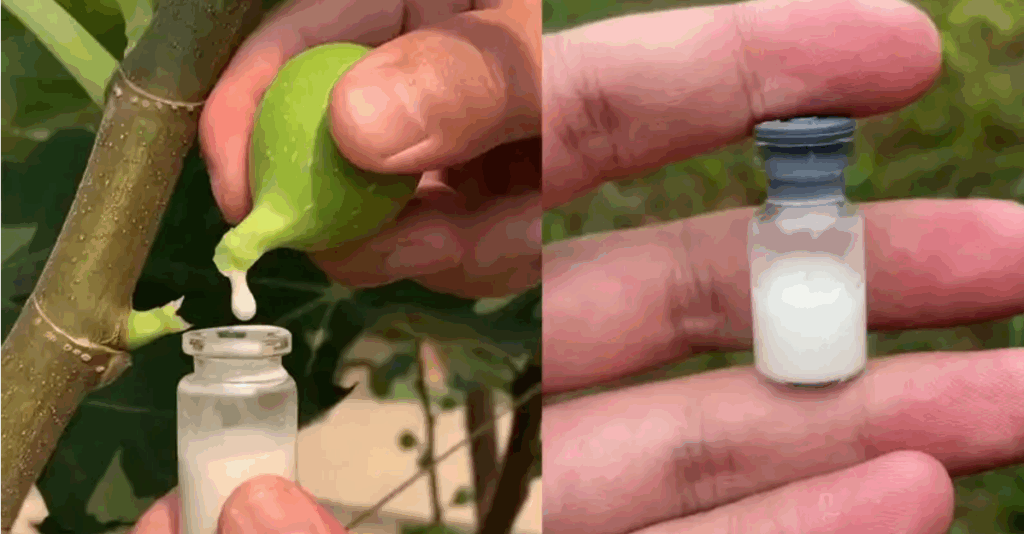Fig Sap (a.k.a. Fig Milk): How to Harvest, Use, and Store Nature’s Hidden Elixir
Tucked away in the branches of the humble fig tree lies a powerful, milky substance known as *fig sap*—or as many call it, *fig milk*. This thick, white latex has been cherished for centuries in folk medicine and home remedies for its wide-ranging benefits.
From healing skin irritations to warding off pests and even making cheese, fig sap is nature’s multi-tool—but with a twist: it must be handled with care.
In this guide, we’ll show you how to collect fig sap safely, explore its top uses, explain how to store it properly, and share important safety notes before you try it yourself.
🌳 How to Collect Fig Sap – Step by Step
1. Pick the Right Tree, at the Right Time: Start with a healthy, mature fig tree (Ficus carica). The best time to collect sap is during the active growing season—late spring through early fall—when the tree is full of life and sap is flowing freely.
2. Gear Up: Safety first! Here’s what you’ll need: Protective gloves and goggles (yes, seriously!) A sharp, clean knife or pruning shears A glass jar or clean container for collection
3. Make a Gentle Cut: Find a young, supple branch or part of the trunk. Make a small, shallow incision—just enough to get the sap flowing. Be careful not to harm the tree more than necessary.
4. Collect the Sap: Hold your container just beneath the cut. You’ll notice the white sap begin to ooze almost immediately. Collect only a small amount—just a few drops go a long way.
5. Help the Tree Heal: Once done, seal the cut with natural mud or a tree-safe sealant. This step is vital to protect your fig tree from infection or pests.

🌿 10 Amazing Uses for Fig Sap
1. Wart Remover: A traditional favorite—dab a little sap directly onto warts daily until they dry and disappear.
2. Ringworm Remedy: Its natural antifungal properties help treat fungal skin infections like ringworm.
3. Digestive Support: In some cultures, diluted fig sap is consumed to ease digestion and relieve mild constipation (always consult a doctor first!).
4. Insect Deterrent: Fig sap works as a natural bug repellent in gardens—perfect for eco-conscious growers.
5. Natural Cheese Coagulant: Yes, really! Traditionally, fig sap has been used to curdle milk in the cheese-making process.
6. Plant Wound Sealant: Seal minor cuts on other plants with fig sap to protect them from infection.
7. Antioxidant Boost: When diluted and used sparingly, fig sap may offer a gentle immune system boost thanks to its antioxidant content.
8. Soothing Skin Treatment: Used cautiously and diluted, it can ease skin irritations—but always patch-test first.
9. Organic Fertilizer Add-In: Mix it with water or compost for a nutrient-rich garden tonic.
10. Natural Pesticide: Its latex can act as a mild pesticide—repelling pests without harsh chemicals.
🧊 How to Store Fig Sap Properly: Use It Fresh: Fig sap is most effective right after collection. Try to use it within a few hours. Short-Term Storage: Need a bit more time? Store it in an airtight glass jar in the fridge. It’ll keep for up to 5–7 days.
Don’t Freeze It: Freezing changes its texture and reduces potency. Keep it natural, cool, and sealed.
⚠️ Important Disclaimer – Safety First! Latex Alert: Fig sap contains natural latex, which can trigger skin irritation or allergic reactions. Always do a patch test on your skin before using it more widely.
Talk to Your Doctor: Planning to ingest fig sap or use it medicinally? Check with a healthcare provider first. Handle With Care: Always wear gloves and avoid contact with eyes and mucous membranes—this sap is powerful and can sting.
Fig sap is a remarkable gift from nature—versatile, potent, and deeply rooted in traditional knowledge. By learning how to collect and use it respectfully, you can tap into its benefits while keeping both yourself and the fig tree safe and healthy.
So, next time you see that milky drip from a fig tree, you’ll know: that’s not just sap—it’s a centuries-old remedy waiting to be rediscovered.


